The first rockets launched into space from
Sweden
Sven Grahn,
Sollentuna,
Sweden
The year was 1961.
In April Gagarin circled
the
earth. On May 25 President Kennedy
announced
the intention of the US to go to the Moon. On August 14, a mere 81
days after Kennedy's "Moon-speech", the first modest step into space
was
taken by Sweden. From a launching tube in a forest clearing just
outside
a missile range in Northern Sweden a tiny Arcas rocket was launched by
a team gathered together for this summer launch from their ordinary
jobs
in universities, government agencies or private companies. Many of the
team members were university students, and one of these students,
Fredrik
Engström, was the president of Swedish
Space Corporation during its first decade.
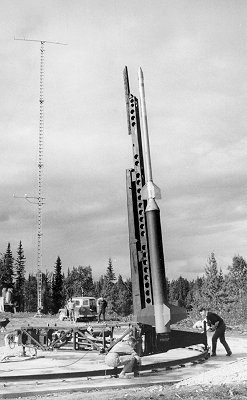
A Nike-Cajun being
prepared
for launch
at Kronogård
1962.
Sven Grahn on the
left.
|
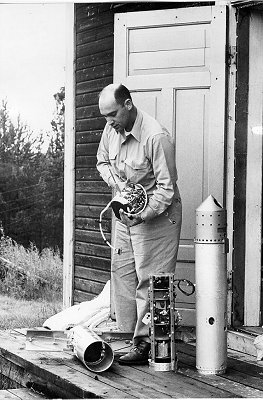
AFCRL's Bob
Sobermann holding
parts of
the payload during
Kronogård
1962.
|
A cloud at 80 kilometers
The objective of this
first
launch was to create an artificial noctilucent ("night-shining") cloud
at about 80 km:s altitude. For a number of years the Institute of
Meteorology
at the University of Stockholm had been doing ground based studies of
noctilucent
clouds and when small inexpensive research rockets became readily
available
at the end of the 1950's the Institute's director, Prof Bert Bolin,
advocated
their use for upper atmospheric studies. Noctilucent clouds were an
ideal
research target, mysterious as to character and origin and spectacular
to look at. The mission of the first rocket was simple: Explode a load
of talcum powder at 80 km. Observed from the ground its optical
properties
could be compared to those of real noctilucent clouds.
The rocket carried no
transmitter,
and after it had left its launch tube, it simply disappeared. It seems
that the artificial noctilucent cloud never went off!
The Kronogård years
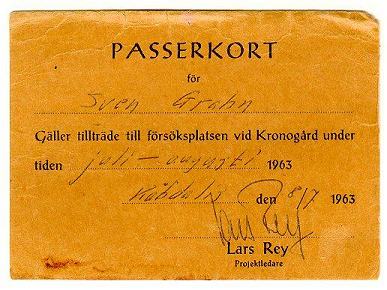 Undaunted,
the team of young scientists and rocketeers started to prepare for a
new
series of rocket launchings planned for the following summer's
noctilucent
cloud season. The Institute of Meteorology had been able to establish a
substantial cooperation with NASA and the US Air Force Cambridge
Research
Laboratory's Meteor Physics Branch. The deal meant that AFCRL provided
four Nike-Cajun rockets with payloads
designed
by Dr Robert Soberman's team for direct sampling of the noctilucent
cloud
particles, NASA a telemetry van for receiving data from the rockets and
various launch pad gear.
Undaunted,
the team of young scientists and rocketeers started to prepare for a
new
series of rocket launchings planned for the following summer's
noctilucent
cloud season. The Institute of Meteorology had been able to establish a
substantial cooperation with NASA and the US Air Force Cambridge
Research
Laboratory's Meteor Physics Branch. The deal meant that AFCRL provided
four Nike-Cajun rockets with payloads
designed
by Dr Robert Soberman's team for direct sampling of the noctilucent
cloud
particles, NASA a telemetry van for receiving data from the rockets and
various launch pad gear.
Sweden's contribution
was
the establishment of a temporary launching base at a derelict farm near
the village of Kåbdalis in the far north of Sweden. The launch
site
at Kronogård had all necessary facilities built up on a temporary
basis: Electrical power, telephone system, loudspeaker, control center,
assembly buildings, direction finding systems for locating the payload
etc. (My 1963 badge for accessing the base is shown on the right).
The project, called
Kronogård
62, was a major undertaking for the Institute of Meteorology, and just
as the year before personnel was "borrowed" from various government
agencies
and recruited from technical universities and even high schools. From
this
cadre of people come several of the senior staff members of SSC! So, in
a sense the company has a 40 year technical tradition.
In a whirlwind of media
attention
the launchings from Kronogård began on August 7, 1962. The last
rocket
in 1962 was launched three weeks later. The second artificial cloud
rocket
left over from the previous year had been launched in this period as
well
as all four cloud-sampling rockets. Two of the sampling payloads had
been
recovered by parachute and were regarded as technical successes.
Getting into the Guinness Book of
Records
During the next two
summers
the noctilucent cloud research at Kronogård continued in
cooperation
with the US. In 1963 atmospheric temperature profiles through the 80 km
level where noctilucent clouds appear were measured by the so-called
sound-grenade
method. The bangs from explosive charges released from a rocket are
observed
from the ground. Since the speed of sound is a function of air
temperature
it is possible to deduct temperature. The launches even got into
Guinness
book of records! The Nike-Cajuns launched in 1963 carrying 12-grenade
payloads
measured a temperature of -143°C at 85 km altitude. The lowest
temperature
measured in the atmosphere!
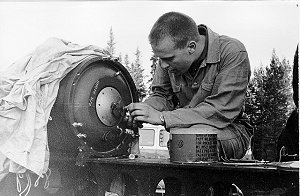
I install the
igniter of
the Nike booster!
|
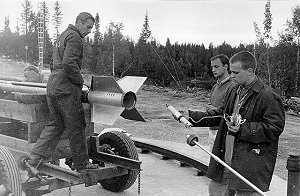
I also prepare the
installation
of the Cajun time-delay
igniter. The rod was
used
to install the igniter.
|
My first "hands-on"
contact
with space technology came during the summers of 1962-64 when I worked
as a rocket assembly technician at Kronogård. This was a great
experience
for a teenager - to be part fo a real launch team at the age of sixteen!
The last rockets from Kronogård
In 1964 the
Kronogård
years reached a fitting climax by the launching of eight rockets. Four
noctilucent cloud sampling rockets and four sound-grenade rockets. The
research into the physics of the upper atmosphere started in
Kronogård
has continued very successfully at the Institute of Meteorology and the
young atmospheric scientist starting his researches in Kronogård,
Georg Witt, is now retired from his position as professor of
atmospheric
physics at the University of Stockholm. The team of engineers that run
the Kronogård 64 operation also contained a "hard core" of
fulltime
employees led by Lars Rey and Lennart Lübeck (now chairman of the
board of directors of the Swedish Space Corporation) and after the end
of the Kronogård operations they continued their existence in
various
organizational forms, but were generally known as the Space Technology
Group. This group had a string of meager years in the late 1960's. But
they survived and in the early 70's constituted a major ingredient in
the
creation of the Swedish Space Corporation.
Epilogue
I visited Kronogård
29
years after the last rocket had been launched. It is now a wildlife
center.
A "heaven" for fisher's and wildlife lovers. The old buildings had been
restored and I soent the night in bunks in the main building, the
farmhouse
that used to be the control center for the launches. My real surprise
came
when we walked out to the launch pads. A little
cottage had been built on top of the concrete slab that was sued
for
the first launch pad. The circular
rail for the
Nike launcher was still there. A few hundred meters from there the
remains of an old Nike booster had been
found. Take a look at some of the pictures I took
- so many years after the last rocket.

 Back
to Space History Notes
Back
to Space History Notes




 Undaunted,
the team of young scientists and rocketeers started to prepare for a
new
series of rocket launchings planned for the following summer's
noctilucent
cloud season. The Institute of Meteorology had been able to establish a
substantial cooperation with NASA and the US Air Force Cambridge
Research
Laboratory's Meteor Physics Branch. The deal meant that AFCRL provided
four Nike-Cajun rockets with payloads
designed
by Dr Robert Soberman's team for direct sampling of the noctilucent
cloud
particles, NASA a telemetry van for receiving data from the rockets and
various launch pad gear.
Undaunted,
the team of young scientists and rocketeers started to prepare for a
new
series of rocket launchings planned for the following summer's
noctilucent
cloud season. The Institute of Meteorology had been able to establish a
substantial cooperation with NASA and the US Air Force Cambridge
Research
Laboratory's Meteor Physics Branch. The deal meant that AFCRL provided
four Nike-Cajun rockets with payloads
designed
by Dr Robert Soberman's team for direct sampling of the noctilucent
cloud
particles, NASA a telemetry van for receiving data from the rockets and
various launch pad gear.


![]()